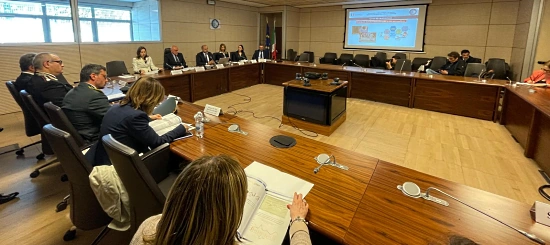Before 2020 working from home was still not widespread in Italy, regulated by a law recently approved (Law 81 of 2017). This is due to a cultural resistance, but also linked to Italy’s backwardness in the field of digitalization.
A new way of working
Almost half (49%) of those working did it remotely since the beginning of the health emergency: 22.8% always or for a long period, 26.2% occasionally/on shift/for a short time. 4.9% of workers say they were already working remotely before the pandemic, while 46.1% were not.
Analysing the data from a geographical point of view different situations arise: the pandemic has led to home working especially for those living in the South (31.8% always or for a long period, 25.2% temporarily) and in the North (in the North-West 24.2% always and 28.4% temporarily; in the North-East 22.4% and 26.5%). Home working has therefore involved the majority of workers in the South and North-West, while the smallest rate is recorded in the Islands, where 12.8% already home worked and 50% did not even with the arrival of the pandemic. The rate of workers in Central Italy is intermediate: 4 out of 10 have started working in smart working (13.8% always, 27% temporarily/occasionally), 55% have not, even in emergency times.
Self-employed and freelancers recorded the highest rate of home workers
The nature of the job consequently affects whether or not people can work remotely. With the health emergency, the majority of employees (66.2%), managers/top managers/directors (65.1%, as much as 46.3% always or for a long period), freelancers (62.4%) had the opportunity of working from home. Not insignificant figures relate to the self-employed workers (45.6%), entrepreneurs (41.8%) and law enforcement/military (37.5%). The lowest percentages are, understandingly, among manual workers (12.4%) and traders (13%). Self-employed and freelancers recorded the highest rate of home workers even before the start of the pandemic (12.6% and 10.3% respectively).
Even while home working the “office working hours model” prevails with standard working time tasks.
In most cases, home working was organised on the basis of fixed working hours (54.4%), in almost a third by objectives (30.2%), while in 15.4% of cases on the basis of an availability without fixed time limits.
A mixed presence-remote mode for the future
By questioning those who have experimented home working about their preferences for the future, it emerges that the majority, being able to choose, would like to alternate work from home and work in presence when the health emergency is over (53%); 28% would like to stop home working, while 19% would like to continue working from home.
Taking into account the family type, the data indicate that among single parents with children, the percentage of those who would like to continue home working is higher (25%); among couples with children, the rate is 20.1%, among couples without children is 18.1% and while among people living on their own it is lower (13.6%).
An overall positive experience
66.2% of those who have home worked say they are satisfied with the work organization, 62% with regard to the working hours management. More than a half was also well coordinated with colleagues (57.5%), with supervisors (56.4%) and workload (56.2%). While positive experience prevails, however, it is important to stress out the not negligible rate of home workers facing difficulties; in particular, 18.7% say they are not at all satisfied with the coordination with their supervisors, 18.3% with the workload. Single parents with children (78.6%) and couples with children (62.7%) are the most satisfied with home working in relation to the personal and working time management.
More than a third of workers had practical difficulties having inadequate tools
While home working, the clear majority of workers have better managed family and domestic commitments (60%) and felt freer (58.2%). On the other hand, there were also negative feelings: 64.2% missed the company of colleagues and 53.9% say the working days were more boring. 46.5% of workers think that they were more efficient at work (in contrast, 53.5% did not) and 45.6% faced difficulties finding guidance and coordination at work. More than a third of workers (34.9%) had practical difficulties, having inadequate/insufficient tools (PCs, smartphones, Internet connection).
Comparing the experiences of men and women while home working, men say more frequently that they felt freer (60.5% versus 55.8%), while women more often claim the working days as more boring (56.5% versus 51.4%). Among those living on their own, more people have missed their colleagues company – 68.2%, compared to 50%, in particular, for single parents with offspring – and those who have found working days more boring – 64.8%, compared to 47.2% of couples with children, 53.6% of single-parent families and 55.2% of childless couples.
Home working? Yes, especially if “IT tools equipped”
Regarding the IT tools provision, which is now indispensable for most of the jobs, the majority of the sample (52.3%) reports that they used their own (pc, smartphone, internet connection), 39.8% were provided by their employer, while 7.9% were partially provided/reimbursed by the company.
From this point of view, the results show considerable differences across Italian territory. In the “Mezzogiorno” (Southern Italy), the vast majority of remote workers used their own IT tools: 68.8% in the South and 64.4% in the Islands. The rate remains the highest in the North-West (54.5%), while it goes down to 41.2% in the Centre and 34.1% in the North-East. In the North-East and the Centre, the computer equipment is in most cases provided by the employer – in 56.1% and 52.9% respectively, compared with 24.8% in the South and 20.3% in the Islands (where 15.3% being reimbursed, even partially, from the employer). The type of employment relationship is also affecting the way of working while remote working. 78.1% of professionals with VAT have their own IT tools, as well as the majority of atypical workers (58.2%) and fixed-term employees (52.2%). Among permanent workers, cases in which IT tools are provided by the company prevail: in 45.1% of cases it provides the tools directly, in 9.8% it provides a reimbursement, even if partially.






















